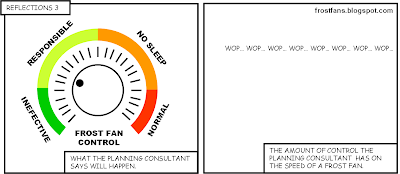Hi there.
For my first post to this blog (thanks Jack) I would like to take the opportunity to address a means of setting limits for noise producing activities (ideally frost fans).
Some may feel as if I've come down on the side of the resident instead of the vineyard owner. But in fact, I've deliberately tried to avoid playing favorites by applying a logical premise that people should be allowed to sleep in their homes. If you think that's a bit over the top, then you are in effect agreeing to being kept awake against your wishes for one night every week for three months. Welcome to the World of frost protection for the inconsiderate.
Following the model below means that vineyards coud actually produce more noise from frost fans if they want, so long as it didn't impinge on peoples ability to sleep.
What is ideal allowable noise level for frost fan activity?
The easy answer is the level that allows for sleep during the night.
The practical aspects of this are more difficult to manage, but that shouldn’t stop us from exploring the options.
First and foremost the World Health Organisation have set out a level of 30dBA Leq as the maximum noise level permissible at night to avoid serious health effects.
This is the level inside a person’s bedroom that allows them to sleep.
That’s where the main thrust of this argument should lay.
The issue is not ‘How much noise is a frost fan allowed to make’.
It is ‘How much quiet does a person need to sleep’.
The widely quoted value for the amount of reduction of noise that occurs in a modern home from the outside to the inside is 20dB (this assumes the windows are closed).
That means that the amount of noise that can be present outside a person’s house that allows them to sleep is 50dBA Leq.
Now setting this level does not take into account a fundamental point. Noise pollution is insidious in the manner that is can be produced and nebulous in the way it can be monitored. Therefore setting a level required outside a house does not allow for a residential section that has yet to be built on or the fact that if a house is set back considerably from a boundary, the noise level that is present in the receivers property exceeds that required if they ever decide to subdivide or re-build in a different position.
Therefore the noise pollution needs to be contained within the boundary of a noise producing property.
Therefore the amount of noise that can be present at the boundary of a property should not exceed 50dBA Leq.
That’s actually still pretty simple. If you want to make noise, ensure that the amount that is present at your boundary is less than 50dBA Leq.
This is where people assume it starts to get more difficult.
What if a property is at a point where two neighbouring (noise producing) properties meet? This would mean that if each (of the noise producing properties) was producing 50dBA Leq then the total would be 53dBA Leq where the three properties meet.
This would exceed the maximum amount of noise that would allow sleep.
Is that so bad though? Surely a regulatory body like a District Council would jump at the chance to ensure that a condition of consent that allowed for safety of the residents was adhered to?
In fact that works out quite well. It is a very simple matter to calculate that in the example above, the measured permitted noise level for each noise producing neighbour should be less than 47dBA Leq at the point where the noise producing properties and their neighbour meet.
In fact this example can extend to describing the allowable noise at any point on the boundary of a property dependant on how your neighbour’s properties abut yours. It is extraordinarily simple.

Any noise produced by ‘Vineyard A’ or ‘Vineyard B’ should not exceed 50dBA Leq at Point ‘A’ or at Point ‘C’.
Any noise produced by ‘Vineyard A’ or ‘Vineyard B’ should not exceed 47dBA Leq at Point ‘B’.
This model ignores the type and number of noise producing sources. Assuming they are frost fans, there can be as many or few as desired. So long as the measured noise at the relevant points on the boundary are within the limits everything is acceptable. This assumes that any testing is carried out in the ‘worst case scenario’ where all frost protection devices are operating (i.e. cumulatively).
Using this model each and every property can carry out frost protection with an achievable target that is independent of having to allow for the noise coming from their neighbours. This protects the rate payer that wants to sleep and gives all noise producers a clear level to meet.
The down side is that there is still a need to monitor for compliance. While conditions can be imposed for stringent testing, there needs to be effective and robust methods of ensuring conditions of consent for noise are being met. I intend to cover possible options in a future post. And guess what. It can be done simply.



















